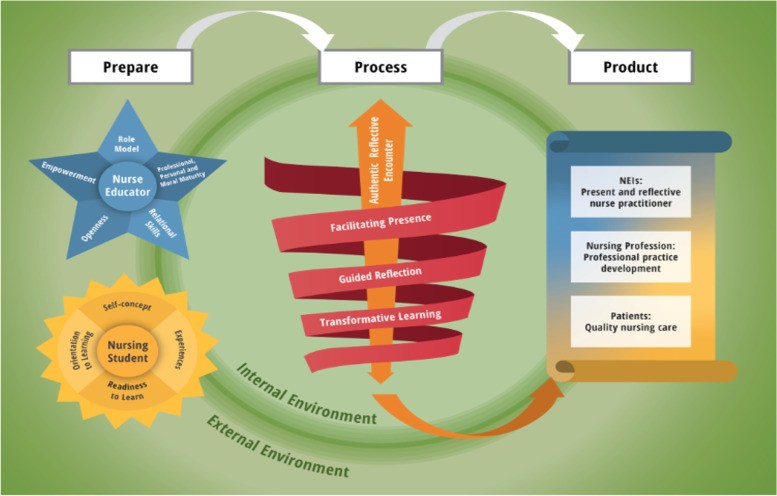Nurse educators play a crucial role in shaping the future of nursing. But how do they effectively facilitate learning, especially in large class settings? This article explores a new model designed to guide nurse educators in fostering presence and utilizing reflective practices to enhance the learning experience for nursing students.
Introduction
The demands on nurse educators are multifaceted, including teaching large classes, supervising clinical practice, and conducting research. These responsibilities can make it challenging to cultivate a learning environment that promotes student engagement and critical thinking. This article delves into a research-based model that addresses this challenge by integrating the concepts of presence and reflective practice into a comprehensive framework for teaching and learning in large class settings. This model aims to answer the question: What does a practice model entail to guide nurse educators in facilitating presence in nursing students through reflective practices as a teaching-learning strategy within large class settings?
Facilitating Presence Through Guided Reflection: The Model
This model, developed through rigorous theory synthesis, offers a structured approach to teaching and learning that emphasizes the educator’s presence and the student’s reflective practice. The model’s core components are outlined below.
Purpose
The model provides a theoretically grounded framework for nurse educators in accredited Nursing Education Institutions (NEIs) to facilitate their presence and guide student reflection in large class settings. This framework aims to enhance the learning process and ultimately improve the quality of nursing education.
Assumptions
The model operates under several key assumptions:
- Nurse educators and students are multifaceted individuals who co-create learning experiences.
- Nurse educators must approach teaching with openness, respect, and dedication.
- Learning is influenced by past experiences and individual perceptions.
- Critical thinking and reflection are crucial for problem-solving in nursing practice.
- Learning objectives should be adaptable to the student’s developmental needs.
- The model is context-bound to large class settings in NEIs.
Context
The model is specifically designed for accredited NEIs in South Africa, adhering to the regulations of the Nursing Act 33 of 2005. It focuses on large class settings in undergraduate nursing programs, acknowledging the challenges and opportunities inherent in this context. The model also addresses the increasing prevalence of blended learning environments, including online classes, and the impact on facilitating presence and reflection.
Structure
The model is built upon the interplay of:
- Framework: The external (legal and regulatory) and internal (teaching-learning environment) contexts.
- Agents: Nurse educators and nursing students as active participants in the learning process.
- Procedure: The teaching-learning process itself, emphasizing guided reflection.
- Dynamics: The authentic reflective encounter between educator and student.
- Recipients/Terminus: The beneficiaries of the model, including the NEI, the nursing profession, and patients, with the ultimate outcome of producing present and reflective nurse practitioners and improved quality of care.
 A model for nurse educators to facilitate presence in large class group settings through reflective practices
A model for nurse educators to facilitate presence in large class group settings through reflective practices
Figure 1: The model for facilitating presence in large class settings.
Process
The model unfolds in three phases:
- Prepare: Establishing a conducive learning environment, building meaningful relationships, and understanding the attributes of both the educator and the adult learner. This phase emphasizes creating a safe and supportive space for learning.
- Process: Implementing the educational encounter through planning, presenting, and evaluating. Guided reflection is central to this phase, fostering critical thinking and transformative learning. This includes strategies like reflective journaling, case studies, and simulations.
- Product: Realizing the outcomes of the model, including the development of present and reflective practitioners, advancements in the nursing profession, and ultimately, improved patient care.
Concluding Statements
Six key statements summarize the model’s core principles:
- A conducive learning environment is fundamental for facilitating presence and reflection.
- Meaningful relationships between educators and students are crucial.
- Nurse educators should embody specific attributes that promote presence.
- Facilitating presence and reflection enhances learning experiences.
- These practices bridge the gap between theory and practice.
- The model contributes to professional development, well-being, and quality of care.
Implications and Future Directions
This model offers valuable insights for nurse educators seeking to enhance learning in large class settings. By embracing presence and fostering reflective practice, educators can create transformative learning experiences that benefit students, the nursing profession, and ultimately, patients. Future research should focus on validating and refining this model, exploring its applicability in other healthcare disciplines, and developing practical guidelines for implementation. This model provides a roadmap for nurse educators to effectively navigate the complexities of large class settings and cultivate a learning environment that produces competent, compassionate, and present nurses.
